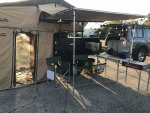That's barely a trickle, why bother?I would love a 5 amp limit on the system.
You are using an out of date browser. It may not display this or other websites correctly.
You should upgrade or use an alternative browser.
You should upgrade or use an alternative browser.
Smittybilt Scout Trailer Reviews?
- Thread starter Tkhawk
- Start date
ebrabaek
Adventurer
Finally took the trailer out for the first time. Happy with the results so far but looking forward to more upgrades.
Wynn, that is a beautiful trailer......and scenery. I can only imagine what a satisfying experience this first time out was for you. We are rolling ours out along the Colorado river just north of Moab this coming Friday.... Whooooheeeeee.
ebrabaek
Adventurer
That's barely a trickle, why bother?
I have a group 27 smaller battery in mine. Even with the tire now located aft on the trailer, tounge weight still have to be kept in check, so I chose a 23 pound battery, as I think it is big enough. That being the case, I saw no reason to increase the chance to " cook" the battery with a high charge on the road. My load is:
Fridge...... 2.3 amps ( non continuous)
Lights1...... 0.65 amps
Lights2...... 1.95 amps
Be as it may, the battery is always kept fully charged while stored in the garage, I simply don't need anything higher from the tow vehicle.
mspenc45
Member
I am measuring 14.1 V at my pin 4 of the 7 pin trailer connector. Without a DC to DC converter, stepping this up, I could not fully charge a 12 V battery. I believe, perhaps a gel cell, but not a flooded or AGM.I have a group 27 smaller battery in mine. Even with the tire now located aft on the trailer, tounge weight still have to be kept in check, so I chose a 23 pound battery, as I think it is big enough. That being the case, I saw no reason to increase the chance to " cook" the battery with a high charge on the road. My load is:
Fridge...... 2.3 amps ( non continuous)
Lights1...... 0.65 amps
Lights2...... 1.95 amps
Be as it may, the battery is always kept fully charged while stored in the garage, I simply don't need anything higher from the tow vehicle.
Did you find a way to limit the current to 5A?
Especially with a fridge you want to extract as much charging from even short trips as possible, well worth a bit of wiring and 4 connectors.
But a 200W solar kit may make more sense for extended boondocking.
And if at all possible, do go to higher AH capacity batt at some point, such a small one won't live long cycling that deeply and not getting back to full. Consider LFP, much lighter, but pricey.
Or just realize you're replacing it more frequently, NBD for most.
But a 200W solar kit may make more sense for extended boondocking.
And if at all possible, do go to higher AH capacity batt at some point, such a small one won't live long cycling that deeply and not getting back to full. Consider LFP, much lighter, but pricey.
Or just realize you're replacing it more frequently, NBD for most.
ebrabaek
Adventurer
I am measuring 14.1 V at my pin 4 of the 7 pin trailer connector. Without a DC to DC converter, stepping this up, I could not fully charge a 12 V battery. I believe, perhaps a gel cell, but not a flooded or AGM.
Did you find a way to limit the current to 5A?
I did not. Not yet at least. I tow with the mighty 2017 Ford Escape which yields 14.3 to 14.4 volt at the battery. Whilst it might not be a full 100% charge, It is pretty darn close. I agree that @ 14.1 you will not get a full charge, but as with many practical applications, it will be close enough. In my case, my 50 watt solar will take the charging voltage to 14.6 and I feel comfortable that this will be enough. My solar charger has a preset for AGM batteries, but for a small $$ you can get a solar charger where you can manually set the charging threshold. That is plan B is plan A is not working.
When I installed the OEM hitch on the Escape, I ran 10 gauge from the vehicle's battery to the plug. Then 12 gauge from the trailer plug to the trailer battery. I did this to minimize voltage drop.
We shall see how this will work in practicality this Friday.
So back to your question, my tow vehicle will give the battery what ever it requests ( amps) up to 15 amps, where after the fuse will bust.
ebrabaek
Adventurer
Especially with a fridge you want to extract as much charging from even short trips as possible, well worth a bit of wiring and 4 connectors.
But a 200W solar kit may make more sense for extended boondocking.
And if at all possible, do go to higher AH capacity batt at some point, such a small one won't live long cycling that deeply and not getting back to full. Consider LFP, much lighter, but pricey.
Or just realize you're replacing it more frequently, NBD for most.
I am not sure if you were thinking of me when you wrote the above, but I will answer as if it was.
I did take a minimalist approach to this. Thus the Engel which draws just under 3 amps the first few seconds after start, but then quickly goes to 2'ish amps, until it turns off. I expect a 30-40% duty cycle in the hot summer. My goal is for the tow vehicle to merely pick up the load while in motion, but realizing that there will be a small voltage drop in the process. What I don't yet know is if that voltage drop is big enough so the trailer battery will not charge. Could be, but I don't know that yet. It should however be a moot point as the trailer battery will always be topped off prior to traveling. So in reality the tow vehicle charge will just need to support the fridge.
I do not think the 27 group battery is too small. Solar will be hooked up through out the day, but off course will not yield a charge in the evening and night. But the draw will also minimize an the fridge will run substantially less.
We shall however see how that works, and off course plan B is a bigger AGM.
Commando Camper
New member
What kind of tent set up do you have? 2 tents?Thanks for the comments. Box on the side is actually a Jeep box that should go behind the back seats of a two door. Not too many of them left out there and is not cheap but I liked the shape of it with the slanted front. The drawback is it only fits on one side of the trailer but I keep my fuel on the other side anyway.
Trailer performed really good on the highway even at high speed but it freaked me out few times when it got really wobbly, I think because of side winds. Maybe it has something to do with independent wheels, it was not swaying just going up and down on opposite sides.
We just came back from riding Hell’s Revenge in the Jeep - what a blast ?. The little Jeep that could.
mspenc45
Member
I did not. Not yet at least. I tow with the mighty 2017 Ford Escape which yields 14.3 to 14.4 volt at the battery. Whilst it might not be a full 100% charge, It is pretty darn close. I agree that @ 14.1 you will not get a full charge, but as with many practical applications, it will be close enough. In my case, my 50 watt solar will take the charging voltage to 14.6 and I feel comfortable that this will be enough. My solar charger has a preset for AGM batteries, but for a small $$ you can get a solar charger where you can manually set the charging threshold. That is plan B is plan A is not working.
When I installed the OEM hitch on the Escape, I ran 10 gauge from the vehicle's battery to the plug. Then 12 gauge from the trailer plug to the trailer battery. I did this to minimize voltage drop.
We shall see how this will work in practicality this Friday.
So back to your question, my tow vehicle will give the battery what ever it requests ( amps) up to 15 amps, where after the fuse will bust.
Seems to me you'd be fine charging anything but an AGM, which requires 14.6 to 14.8V. I just ordered a spool of 12AWG and 10AWG, so I'll have the option. Seems you'd benefit from your vehicle charging your ship battery if you plan on multi location visits, thus the battery would get a charge between locations, but if your trips are more of the model, home to wherever you are camping, and then stay, solar or gen charging would make more sense.
I was assuming extended camping with no access to mains, and a 35-40AH draw in hot weather is the norm for even a very efficient fridge.
I usually stay put free camping for many days if not 2 weeks between starting up the TV engine.
A quiet little inverter genny with a good and right-sized mains charger run in the morning can give great flexibility.
I usually stay put free camping for many days if not 2 weeks between starting up the TV engine.
A quiet little inverter genny with a good and right-sized mains charger run in the morning can give great flexibility.
mspenc45
Member
Considering a couple of these, plus a good quality charge controller. Many of the charge controllers that come with panels, are pre-set voltage for flooded, not AGM batteries.
https://www.amazon.com/s/ref=sr_qz_...m+Design)&unfiltered=1&ie=UTF8&qid=1524513092
Any recommendations on charge controllers?
https://www.amazon.com/s/ref=sr_qz_...m+Design)&unfiltered=1&ie=UTF8&qid=1524513092
Any recommendations on charge controllers?
ebrabaek
Adventurer
Considering a couple of these, plus a good quality charge controller. Many of the charge controllers that come with panels, are pre-set voltage for flooded, not AGM batteries.
https://www.amazon.com/s/ref=sr_qz_back?sf=qz,rba&rh=i:lawngarden,k:Renogy+100+Watt+12+Volt+Monocrystalline+Solar+Panel+(Slim+Design)&keywords=Renogy+100+Watt+12+Volt+Monocrystalline+Solar+Panel+(Slim+Design)&unfiltered=1&ie=UTF8&qid=1524513092
Any recommendations on charge controllers?
I have this unit. It does work with AGM batteries.
https://www.amazon.com/ACOPOWER-HY-...4513451&sr=1-5&keywords=50+watt+solar+charger
ebrabaek
Adventurer
Added a smittybilt awning to ours and really like it View attachment 444868
That looks great. I like your table.

